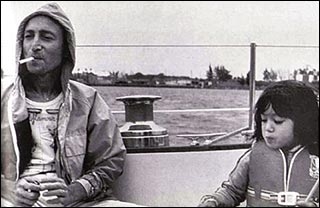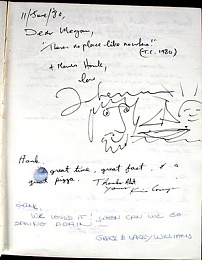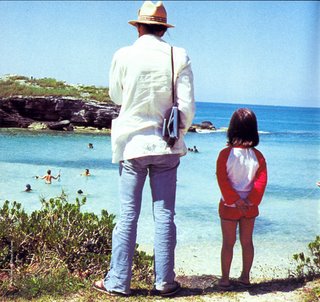As we wait for the sailing season to begin again, a story from Paste magazine.com by John Clarke.

John and Sean Lennon aboard the MEGAN JAYNE in 1980
A captain’s logbook from a sailing trip John Lennon took in 1980 might have some people wondering what the former Beatle was doing in the middle of the Atlantic sailing in a 43-foot schooner with four strangers and a mysterious figure known only as “Captain Hank.” The answer? Shaking off a five-year bout of writer’s block.
The book—which surfaced at a recent auction held by London rock-memorabilia house Cooper Owen—is signed by several sailors and guests of the vessel Megan Jaye and includes notes and doodles made by Lennon during the stormy 600-mile voyage from Rhode Island to Bermuda in June 1980. “Dear Megan,” reads one inscription, “There is no place like nowhere. And thanks Hank. Love, John.” Along with his notes, Lennon drew a picture of himself with a beard, sailing the Megan Jaye through the Bermuda Triangle. The book also contains other entries and anecdotes that touch upon the importance of this Bermuda trip, which is credited with lifting the Beatle out of depression and inspiring him to begin writing his last album, Double Fantasy. Lennon, rock historians say, considered the Bermuda trip one of the most important events of his life.
“He had not been inspired like that since 1961 when he was starting off with The Beatles,” says Tom Fontaine, owner of the Megan Jaye logbook, who also worked on the recent film The U.S. vs. John Lennon (see Paste #24). “The experience gave him the confidence in himself to go back and write his final works. It’s an important piece and I want it to go to the right person.”
While the logbook was withdrawn from the Cooper Owen auction because it failed to meet the reserve, people will get a chance to view it (and even buy it) Dec. 9 at the Hard Rock Hotel in Las Vegas at a charity auction for the TJ Martel Foundation. (Some experts estimate it will be auctioned for as much as $43,000. Fontaine estimates it at $35,000. It was last sold for more than $8,000).
‘SEA LEGS’
According to the Cooper Owen auction catalog, the sail from Newport, R.I., to Hamilton, Bermuda, was an epic voyage for Lennon. On day three, the Megan Jaye ran into rough weather and, one by one, the crew fell ill from pitching seas. Lennon, after 15 minutes at the wheel in his foul-weather gear, began to get his sea legs. He said the feeling was just like going on stage. “At first you panic and then you’re ready to throw up your guts,” Lennon recalled in a Playboy interview after his trip. “But once you got out there and start doing all the stuff, you forget your fears and you got high on your performance.
 “So there I was at the wheel with the wind and sea lashing out at me. At first I was terrified, but Captain Hank was at my side so I felt relatively safe because I knew he wouldn’t let me do anything stupid. After a while Captain Hank wasn’t feeling too well so he went to the cabin below.
“So there I was at the wheel with the wind and sea lashing out at me. At first I was terrified, but Captain Hank was at my side so I felt relatively safe because I knew he wouldn’t let me do anything stupid. After a while Captain Hank wasn’t feeling too well so he went to the cabin below.
“Once I accepted the reality of the situation, something greater than me took over and all of a sudden I lost my fear. I actually began to enjoy the experience and I started to shout out old sea shanties in the face of the storm, screaming at the thundering sky.” Lennon also compared the experience to when The Beatles were at their peak, saying he felt “centered” and “in tune with the cosmos.”
Tyler Coneys was a member of the crew, which included his cousins Kevin and Ellen and Captain Hank. Earlier that spring, Lennon, 39 at the time, had purchased a 14-foot sailboat from Coneys Marine in Huntington, N.Y. (“It was a ‘wet-ass’ boat,” says Coneys. “Not the kind you buy when you just start sailing at 40.”)
Coneys says the Atlantic crossing was Lennon’s longtime dream. “When guys turn 40 some buy a sports car or a motorcycle. Well, Lennon wanted this experience. They say life begins at 40. And this is what he wanted.”
If Coneys had any doubt of Lennon’s grit and toughness, it was washed away during the gale. “It was a huge storm and everyone thought we might die,” says Coneys. “We were in the middle of it and the waves looked like the size of buildings. He could have been watching TV but instead he decided to be there by choice. Right there in it. It was the perfect situation, I guess. All your life you dream about an adventure. You can’t make something like that happen.”
On the boat, Coneys said Lennon had no superstar pretense and fulfilled his ship duties like the rest of the crew. “He was really just one of the guys,” Coneys says. “But he came through. It was right in the heart of the worst part of the storm and he stepped up.”
NEW WIND FOR THE SAILS
 With the cathartic six-day journey behind him, Lennon arrived on the island June 11 relaxed, re-energized and inspired. He stayed for two months—writing, recording and staying up all night working on his new songs, and visiting clubs and shops in downtown Hamilton. On a trip to the Botanical Gardens with his son, Sean, they spotted a freesia hybrid flower called Double Fantasy and thus the album title was born. Another time, having drinks with two local journalists, Lennon came up with the lyrics for “Watching the Wheels.” On the club’s walls flashed projections of turning wheels while one of the journalists lamented to Lennon that he should be writing great songs—not shut in a New York apartment, no longer part of the “big time.” During his stay, he also wrote “I’m Losing You,” “Beautiful Boy” and an early version of “Woman.” During that last summer vacation of his life, Lennon was also inspired to write “Borrowed Time” after listening to Bob Marley and the Wailers’ album Burnin’. In one of his less-poetic moments, he later described this productive time as “a diarrhea of creativity.”
With the cathartic six-day journey behind him, Lennon arrived on the island June 11 relaxed, re-energized and inspired. He stayed for two months—writing, recording and staying up all night working on his new songs, and visiting clubs and shops in downtown Hamilton. On a trip to the Botanical Gardens with his son, Sean, they spotted a freesia hybrid flower called Double Fantasy and thus the album title was born. Another time, having drinks with two local journalists, Lennon came up with the lyrics for “Watching the Wheels.” On the club’s walls flashed projections of turning wheels while one of the journalists lamented to Lennon that he should be writing great songs—not shut in a New York apartment, no longer part of the “big time.” During his stay, he also wrote “I’m Losing You,” “Beautiful Boy” and an early version of “Woman.” During that last summer vacation of his life, Lennon was also inspired to write “Borrowed Time” after listening to Bob Marley and the Wailers’ album Burnin’. In one of his less-poetic moments, he later described this productive time as “a diarrhea of creativity.”
By all accounts it seemed the sail to Bermuda and his following stay allowed Lennon a rare, much-needed degree of anonymity—and the breezy freedom to create unfettered. It was easy living, that relaxed Caribbean-Anglo vibe, and he was making plans to return the next summer. However, nobody can be quite certain if that would have been by boat or plane. And still, all we know about Captain Hank is what Lennon told us. “He looked like the man on the Zig-Zag rolling papers, with a beard and a scarf on his head and a sextant.”